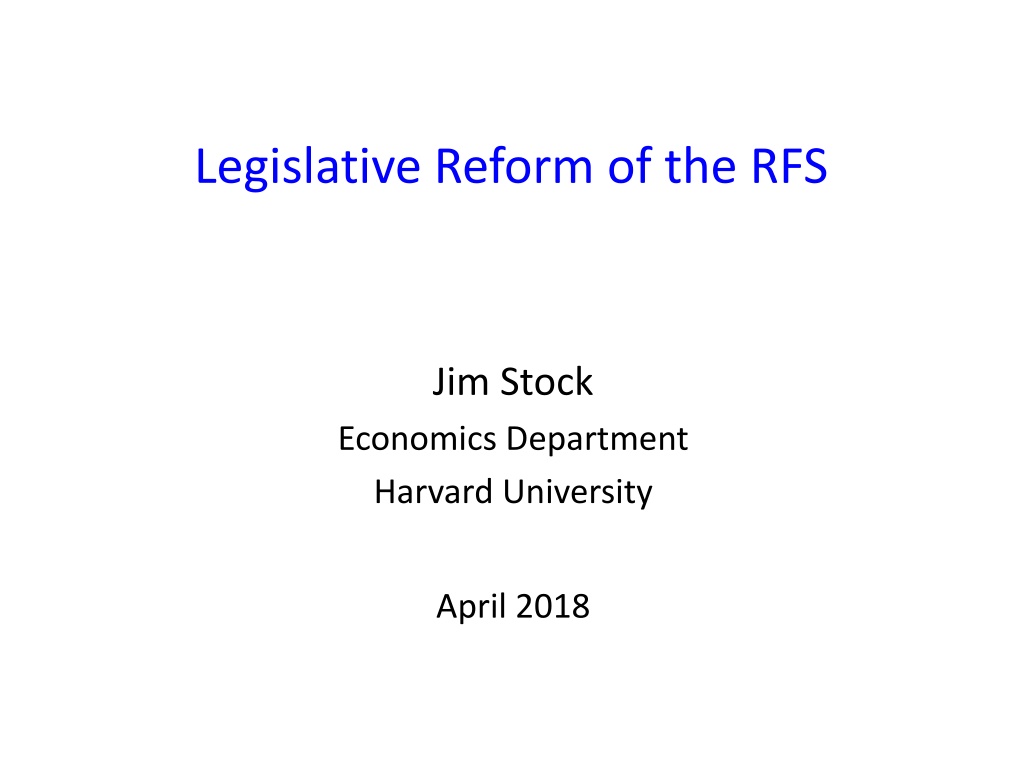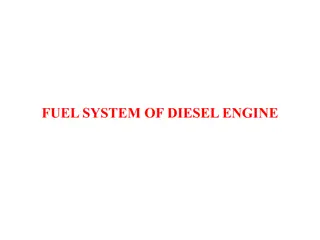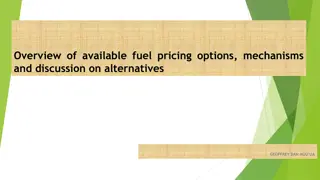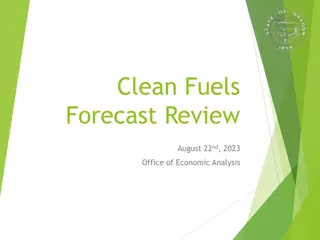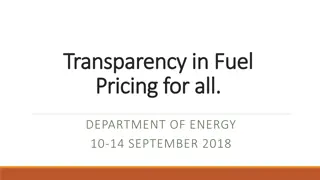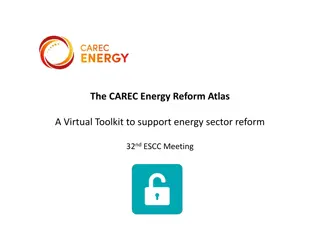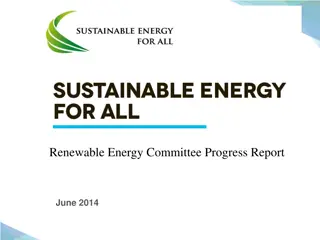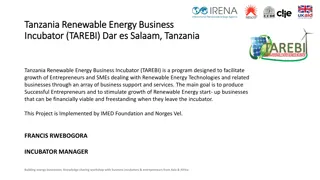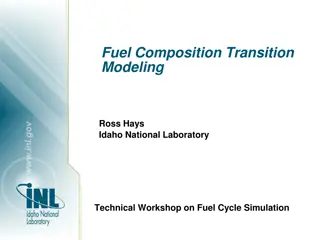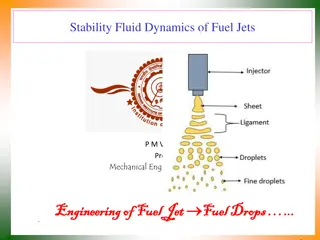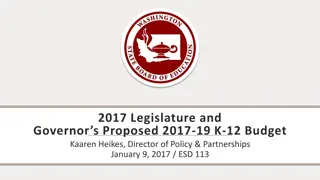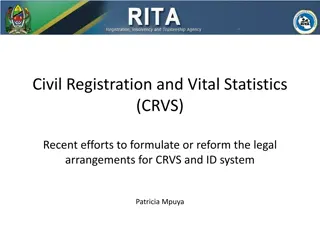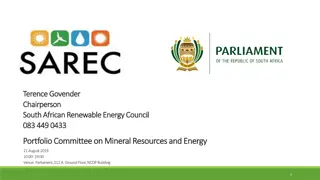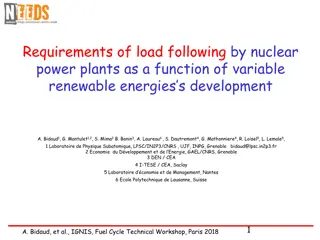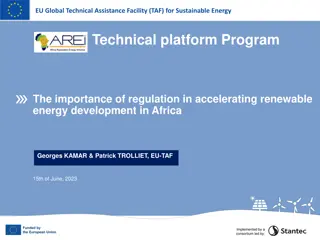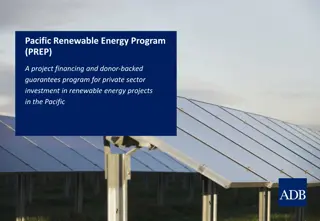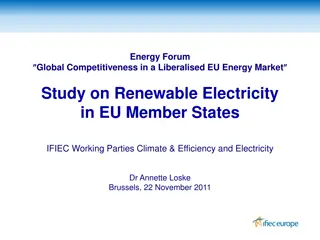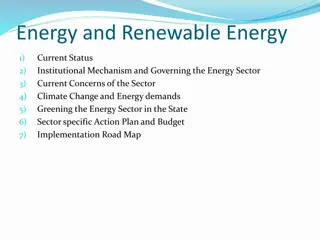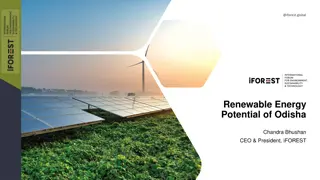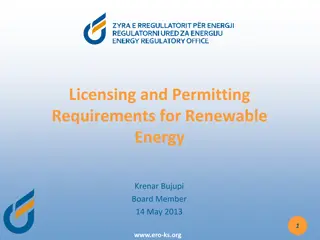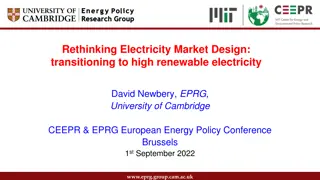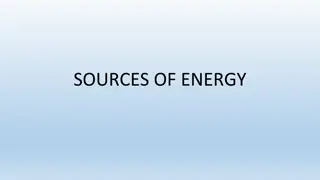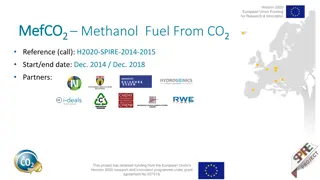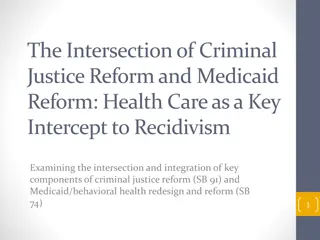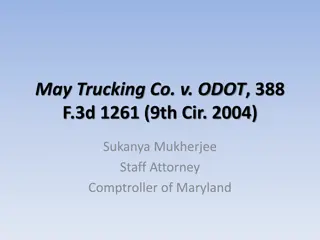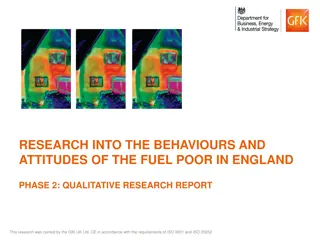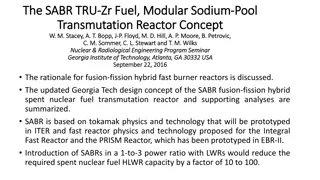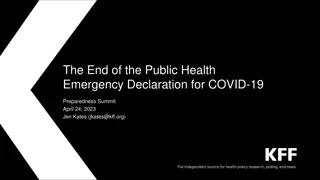Legislative Reform of the Renewable Fuel Standard Act
Brief history of biofuels policy, problems with the Renewable Fuel Standard (RFS), elements of a legislative RFS reform package, policy driving biofuels production, and three reasons to reform the RFS due to high and volatile RIN prices, declining demand for corn ethanol, and slow market penetration of ethanol blends.
Download Presentation

Please find below an Image/Link to download the presentation.
The content on the website is provided AS IS for your information and personal use only. It may not be sold, licensed, or shared on other websites without obtaining consent from the author. Download presentation by click this link. If you encounter any issues during the download, it is possible that the publisher has removed the file from their server.
E N D
Presentation Transcript
Legislative Reform of the RFS Jim Stock Economics Department Harvard University April 2018
Summary and Outline A. Brief history of biofuels policy, the RFS, and biofuels expansion B. Problems with the RFS 1. High and volatile RIN prices means high and volatile compliance costs 2. Failure of higher ethanol blends to expand despite 5 years of high D6 RIN prices 3. Failure of 2G technologies to achieve commercialization These problems are the result of structural deficiencies in the EISA: durable and successful reform requires legislation. C. Elements of a legislative RFS reform package 1. Goals of RFS reform 2. Reformed nesting structure 3. First gen reform a) D6/D8 b) E10+ RVP waiver c) Revenues for blender infrastructure and conservation programs d) Sunset 4. Second gen reform (provide reliable long-term incentives while capping costs) 2
Policy Has Driven Biofuels Production and Use First generation biofuels has doubled since 2006, and now is the equivalent of roughly 1 million barrels per day of refined petroleum product. Of the many policy drivers, the two most important were in the Energy Independence and Security Act (EISA) of 2007 o Ending the use of MTBE as an oxygenate drove an immediate switch to ethanol, the lowest-cost alternative o The RFS gave producers the confidence to build ~15bgal of ethanol plant capacity (the statutory volumetric target for conventional renewable fuels) o The RFS also drove demand for biomass- based biodiesel (BBD) Ethanol is the lowest-cost oxygenate and octane booster and blending it up to 10% does not require a subsidy. BBD is more expensive than petroleum diesel and has always required a subsidy 3
Three Reasons to Reform the RFS 1. RIN prices, and thus compliance costs, are volatile, and since 2013 have been high. RINs are tradeable electronic certificates that are separated from renewable fuels when they are blended. RINs must be retired with the EPA by obligated parties (refiners, importers) to demonstrate compliance. RIN costs surged when ethanol penetration hit the E10 blend wall in early 2013, driving up the price of the D6 (conventional) RIN. >95% of compliance costs are for first-gen fuels. Some merchant refiners argue that they cannot fully pass through their RIN costs to the market, so that high RIN prices are a large financial burden on their industry. o Although academic studies suggest that pass-through to wholesale prices is complete on average, some individual refiners could face incomplete pass-through. o And in any event, RIN price volatility creates compliance cost risk. To reduce total compliance costs, the total RIN price burden must fall. Reducing RIN price risk requires stabilizing RIN prices. 4
Three Reasons to Reform the RFS 2. Without changes, the corn ethanol industry faces declining demand. The use of ethanol as an oxygenate and octane booster has supported rural incomes. But market penetration of ethanol blends in excess of 10% (E15, E85) has been slow. In its 2018 Annual Energy Outlook, EIA projects gasoline demand to decline by 16% by 2025 and by 24% by 2030. o Why? Electric vehicles, improved fuel economy, changing driving patterns, o Without changes, fuel ethanol use will decline in step with gasoline demand. o There is a large potential market for E15 but with insufficient dispensing infrastructure and seasonal sales restrictions, RIN prices have not been enough: The total ethanol blend ratio rose only from 9.7% in 2012 to 10.2% in 2017. Domestic ethanol consumption will decline unless a substantial fraction of E10 sales can be converted to E15 or other higher blends. 5
Three Reasons to Reform the RFS 3. The RFS has failed to promote second generation fuels A key EISA goal was to promote low-GHG second-gen domestic biofuels from non- food feedstocks. Low GHG liquid fuels will very likely be an important part of decarbonization over this century (air and marine transport, long-haul, remote locations). 2G technology has been demonstrated, but initial plants require reliable support. Technology-driving programs have worked: the EV income tax credit, solar incentives, and the wind PTC all drove down product costs by providing reliable bankable temporary price supports for first-stage plants and production. o In contrast, the RFS does not provide long-term support certainty needed to support capital intensive projects. Instead, RIN prices are volatile, producers face regulatory risk, the D3 is capped based on BOB prices, etc. In short, the D3 support cannot be taken to the bank. Second generation fuels have not failed the RFS has failed second generation fuels. 6
RFS Reform: Goals and Policy Mechanisms Goal Policy mechanism Eliminate regulatory uncertainty Replace annual rulemaking by rules-based approach with guard rails Reduce and stabilize compliance cost Set the D6 RVO so it can be met by ethanol blended into E10 Ethanol blended in excess of 10% generates a D8 RIN, with D8 RIN price cap implemented by a D8 waiver credit Reduce regulatory uncertainty by replacing annual rulemaking with rules-based approach with guard rails Promote higher ethanol blends Extend the RVP waiver to blends >E10 Provide reliable support for second generation fuels Stabilize RIN prices for second generation fuels Provide certainty that second gen plants will receive RIN price support for long enough to justify the capital expenditure and R&D 3. Second generation fuels have not taken off as hoped Provide revenues for biofuels infrastructure and conservation From sales of D8 waiver credits Sunset Phase out D8 RVO and D8WC price after initial period Phase down D4 RIN price after initial period Second gen: o Begin program with a cumulative RIN quantity cap o Program sunsets after all RINs are used up 7
RFS Reform: D6/D8 + D4 denesting + 2G denesting Proposed Nesting Structure First generation fuels Second generation fuels Biomass- based diesel (D4) Low GHG Biogas Advanced (D9) Lifecycle reduction in greenhouse gas emissions: [60%] D3d Liquid < 90% GHG Non-E10 Conventional (D8) Ethanol blended in excess of 10% Lifecycle reduction in greenhouse gas emissions: 50% D3c Liquid < 80% GHG D3b (no changes to the D4 pool) Liquid < 70% GHG Conventional (D6) Ethanol blended into E10 D3a Liquid < 60% GHG Second gen fuels are defined by performance (GHG reduction and gas/liquid), not feedstock Cellulosic ethanol generates both a D3 and D6 RIN First gen fuels de-nest ethanol and BBD, which have their own RVOs. Ethanol RVO is 15 Bgal 8
First-Gen Reform: BBD under Ethanol/BBD Denesting BBD denesting: o Fuels All pathways currently generating a D4 RIN continue to generate a D4 RIN BBD pathways currently generating a D6 RIN no longer generate a RIN o RVO management can be done volumetrically, through a managed RIN price, or volumetrically with a RIN price cap. The BBD RIN price can be pegged to a declining cap, with a phase down during a transition period. For example the D4 price could be set to $1 for an initial period, then phased down over a transition period, to a new price ceiling. Alternatively, the BBD RVO can continue to be set annually, but with additional statutory clarification and/or with a statutory RIN price cap 9
First-Gen Reform: Worked Illustration The following slides work through an example of the effects of D6/D8 reform on o Total compliance costs for first generation fuels o Acreage planted for corn o Revenues generated by sale of D8 waiver credits Two ethanol scenarios: o Low: ethanol fraction of gasoline supply stays at 10.2% (2017 value BAU) o High: ethanol fraction rises to 12.5% over 7 years, starting in 2019 (half of E10 sales are converted to E15) Modeling assumptions: D8WC price of $2 which, starting in 2021, phases down by $0.30/year to $0.35 in 2026; ethanol RVO is 15Bgal subject to D8WC sales cap of 500mgal through 2021, becoming 150mgal in 2022. If fully passed through, a D8WC price of $2 would result in a E15 pump price discount of $0.10 and a E85 price discount of $1.30 (at 74% ethanol), both compared to E10. 10
First-Gen Reform: Compliance Costs Gross compliance costs for first generation ethanol falls by 75%, compared to 2017 The gross compliance cost is the total value of ethanol RINs If E15 expansion is even more rapid so that total ethanol sales hit 15 Bgal, the D8 RIN price would fall and compliance costs would be reduced 11
First-Gen Reform: Corn Acreage Corn acreage does not increase, even under the high ethanol scenarios Under both the high and low ethanol scenarios, corn acreage planted for ethanol is restrained because of (in order): falling gasoline demand, increasing corn yields, and improvements in ethanol plant efficiency. 12
First-Gen Reform: Revenue from Sales of D8WC Sales of D8 Waiver Credits will generate net revenue EPA generates revenue by selling D8WCs, subject to a cap. The amount of revenue depends on the number of D8WCs sold. The greater the expansion of E15, the fewer D8WCs will be sold. The D8WC revenue can be used to fund blender infrastructure and land conservation programs. Revenues (and total compliance costs) would be less if a fraction of legacy D6 RINs are converted to D8 to ensure a D8 generation also depends on how legacy D6 RINs are handled. 13
First-Gen Reform: D6/D8 Implementation One mechanism for D6/D8 implementation i. D6 RIN generation and retirement remains unchanged. The point of obligation remains unchanged There are no new requirements for tracking fuels at the rack ii. Retailer participation in the D8 program is voluntary For retailers that do not sell higher blends, or that sell higher blends but choose not to participate in the D8 program, there are no changes iii. EPA grants one or more certified third-party entities authority to convert a D6 RIN to a D8 RIN, based on actual station-level sales. These entities use station-level data on actual retail sales, by blend including actual blend ratios, to compute the number of gallons sold in higher blends in excess of 10%. For example, a station that sells 100 gallons of E0, 2000 gallons of E10, 100 gallons of E15 at 15% ethanol, and 100 gallons of E85 at 68% ethanol, would be eligible for .05 100 + .58 100 = 63 D8 RINs. The third-party entity then converts the indicated number of D6 RINs into D8 RINs, which becomes the property of the retailer. There is no molecule tracking: the converted D6 RIN can be purchased on the D6 market. The retailer could stipulate that the third-party entity sell the D8 RIN and give the retailer the proceeds, in which case the retailer would not need to touch the RIN or the EMTS iv. The third-party entity would be responsible for quality assurance and would be subject to EPA audit. The entity would be required to have a quality assurance program in place This structure is similar to one already in use in the program, for generating D3 biogas RINs. Variants are possible. The key elements are: use of retail data; voluntary participation; delegation of authority to convert D6 to D8 RINs to a certified entity which is subject to audit; and no molecule tracking. 14
Second Gen Reform: RIN Allocation and Generation Allocation of RIN generation rights i. RIN allocation Upon certification, a plant is allocated RIN generation rights (RIN options) up to the capacity of the plant, for a 20 year lifetime commencing at a specified date (e.g. upon pathway approval) The RIN that can be generated (e.g. D3c) depends on pathway GHG reduction Every (EV-adjusted) gallon produced during the eligibility period generates a RIN of the indicated type A plant that fails to become operational during an initial specified period forfeits its RIN allocation, which is returned to the available RIN pool. If the plant makes pathway improvements that reduce its GHG footprint, the RIN can be upgraded, if RINs of the upgraded category are available. Caps and sunset Total RIN cap. Each category (D3a, D3b, etc.) has an initial total number of RINs available Drawdown. Award of RIN generation rights (RIN options) reduces the number of RINs available in that category Nesting. If a pathway is eligible for (say) a D3c RIN but no D3Cs remain available, it would be granted D3b allocation rights if D3bs are available, etc. Sunset. No new RIN options are awarded once all D3 RINs have been allocated. ii. iii. Liquid and gas denesting Denesting liquid and gas recognizes the importance of promoting low- GHG liquid fuels D3s are nested internally The D3dWC price is set above the D3cWC price, etc. The initial D9 RIN allocation and D9WC price should be sufficient to support existing and in-process biogas facilities. iv. 15
Second Gen Reform: RIN Price Stabilization There are (at least) two ways to ensure prices of second gen RINs. Option A: Set RVO ex-post i. Set the D3 RVO ex-post to equal actual production, plus a small amount Thus D3s will always be in short supply EPA issues a provisional fractional standard before the year, and updates it regularly as D3 generation data become available over the year. The D3 fractional standard is finalized after the compliance year concludes, when final D3 generation data are available EPA sells D3WCs only at the end of the true-up period when no more wet D3s for the compliance year are on offer at a price no more than the D3WC price One way to implement this is to require all wet D3s to be sold on a site that EPA can monitor, so EPA knows if wet D3s are available. True-up could be implemented quarterly or semi-annually if parties prefer. New D3 RINs are not bankable, nor are carry-forward deficits allowed. EPA is instructed to manage the program to ensure the D3 sells at or close to the D3WC price. ii. iii. iv. Option B: EPA serves as a RIN bank i. Set RVOs to equal expected RIN generation EPA issues fractional standard ex-ante which are finalized (as in current system). RINs are not bankable. EPA buys and sells RINs, at price based on a schedule specified in statute. EPA only sells RINs if no wet RINs are on offer at the statutory RIN price, and only at the end of the true-up period. This alternative eliminates per-gallon compliance cost uncertainty for obligated parties and has no effect on D3 RIN generators, however EPA takes on expenditure or revenue volatility risk. ii. iii. 16
Additional Reading For additional details and discussion see Stock, James H. (2018). Reforming the Renewable Fuel Standard. Columbia Center on Global Energy Policy at http://energypolicy.columbia.edu/research/report/reforming-renewable-fuel-standard. 17
